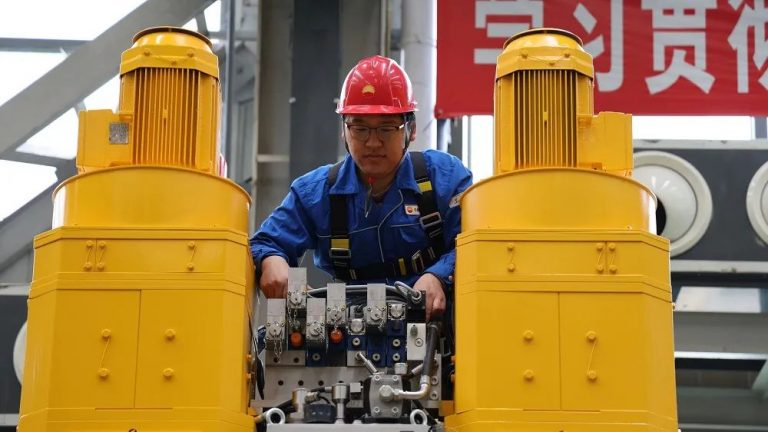
By Wu Yan, Lyu Li, Located in northwest China’s Xinjiang Uygur autonomous region, Tarim Basin is a major petroliferous basin in the country. The oil and gas resources at a depth of more than 6,000 meters underground in the basin account for 83.2 percent and 63.9 percent, respectively, of China’s total.
Currently, China’s exploration and development of the Tarim Basin has entered a comprehensive phase of ultra-deep drilling, and the largest ultra-deep oil and gas field in China has been built there.
In Xayar county, Aksu prefecture, a gigantic white-and-red derrick is standing in the desert, with the deafening sound of drilling rigs. This is the site of a drilling project of the Take-1 well by PetroChina, China’s leading oil and gas producer.
With a design depth of 11,100 meters, the exploration well will be the first in China with a depth of more than 10,000 meters.
In a prefab house beside the derrick, there is an intelligent control platform, which comes with a big screen that displays all types of construction parameters and real-time surveillance videos. It shows the progress of the drilling project.
So far, the well has been drilled to a depth of 5,856 meters, according to Wang Chunsheng, chief technical expert of the Tarim oilfield branch of PetroChina.
In the Tarim Basin, there are many other drilling projects probing deep into the Earth.
According to statistics, PetroChina’s Tarim oilfield is home to over 1,700 wells with a depth of more than 6,000 meters, which account for over 80 percent of China’s total. In particular, more than 100 of them have reached or exceeded the depth of 8,000 meters.
In general, a well between 4,500 and 6,000 meters deep is defined as a deep well, while those between 6,000 and 9,000 meters are super-deep wells. Those that are more than 9,000 meters are ultra-deep wells.
It is the overall improvement of industrial manufacturing capabilities that has enabled China to drill wells thousands of meters underground.
The completion of the 11,100-meter drilling project is estimated to take 457 days. So far, over half of the targeted depth has been completed in just dozens of days, but that is less than 10 percent of the total workload.
As the depth increases, the difficulty of drilling grows exponentially, explained Duan Yongxian, manager of the geological investigation division of PetroChina’s Tarim oilfield branch.
“The deeper you drill, the higher the pressure and the temperature it will be. At over 10,000 meters underground, we face challenges like ultra-high temperatures above 210 degrees Celsius and pressures above 130 MPa,” Duan noted.
Drilling rigs are the “heart” of ultra-deep drilling projects. A 72-meter-high rig is adopted for the project of the Take-1 well, as tall as a 24-storey building.
Independently developed by China, the rig is the first one in the world able to drill to a depth of 12,000 meters. Compared with regular rigs, it has improved its lifting capacity from around 300 or 400 tons to 900 tons, which means it can lift 150 adult elephants at once.
Besides, the rig is equipped with high-performance PDC drill bits and fluids that ensure work efficiency in extreme temperatures.
How are oil and gas discovered in the deep underground?
Some metal rods are equipped with downhole logging tools that can work at a temperature of 200 degrees Celsius and transmit real-time drilling data 8,000 meters below the surface to the ground control platform. They help the drill bits to find the right directions.
Ultra-deep drilling is the field with the most bottlenecks and challenges in oil and gas engineering, facing extreme temperatures, ultra-high pressures, and fragile strata. The complex underground rock combinations in the Tarim Basin make the drilling even more difficult.
The Tarim Basin ranks first globally in seven of the 13 globally recognized indicators for engineering difficulty, and it also ranks high in the remaining indicators, Wang said.
In recent years, relying on major scientific and technological projects, China has made multiple innovative achievements in geological theory and engineering technology, laying the foundation for exploring ultra-deep resources.
World-leading 3D seismic technology also allows researchers to clearly “see” the stratigraphic structure where the well is located, like a CT scan of the formation, making the intricate underground oil and gas veins even more distinct.
However, sometimes drilling is still like “opening blind boxes” despite the systematic scientific support, said Zhang Yu with Sinopec’s northwest oilfield branch.
According to Zhang, the exploration wells drilling for oil and gas can reach a success rate of more than 50 percent in China, much higher than the world average of 30 percent.
At the drilling site of PetroChina’s Take-1 well, numbered boxes containing rock cuttings were arranged in rows, with numbers denoting the depths the samples were extracted from.
In addition to finding oil and gas, the project is also tasked with scientific exploration. These ultra-deep wells are searching for the secrets deep in the Earth, unearthing mysteries of the planet’s interior and evolution, and providing data for further studies of geoscience.










